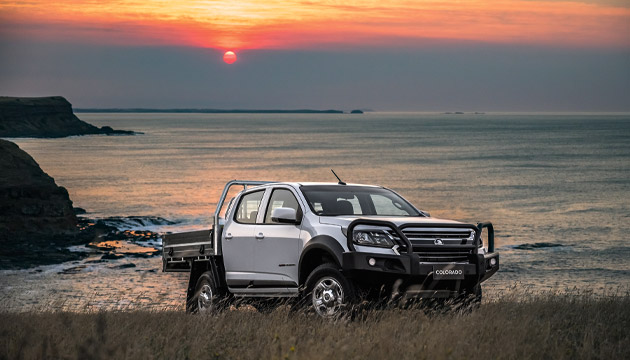Holden’s versatile and confidence-inspiring Colorado.
Story Bruce McMahon
Australians have loved utes from the great day in the 1930s when Ford’s Lew Bandt drew up his design for a ‘coupe utility’ – comfortable cabin up front to take the wife to town, cargo tub out back to take the pigs to market.
Ford and Holden utes went on to rule the country’s highways and byways as working vehicles for farmers, small-business owners and tradies. These two-door, passenger-car derivatives sold alongside Falcon and Commodore sedans through to the 1990s, when the streetscape began to change. Ford and Holden utes became lower and sleeker and, in some quarters, more of a fashion statement than a utility vehicle. Long gone were the high-riding Kingswood utes that could straddle a station track. At the same time, Australians were embracing four-wheel-drive vehicles, and discovering the versatility of four-door utilities for work and play.
Today, our roads, beaches and bush tracks see swags of dual cab, 4WD utes on the move. Among these is Holden’s Colorado, one of the company’s best sellers.
Since splitting with Isuzu (maker of the Rodeo and D-Max) in 2016, Holden’s 4WD ute has developed its own character. From 2017 the Colorado has sported a 2.8-litre Duramax engine, plus reworked suspension and steering to best suit Australian conditions.
The four-door Colorado Crew Cab has a simple, yet handsome nose and a straight-laced approach to its profile, with no flamboyant swoops to the bodywork. Fancy versions – there are four trim levels, from mild to wild – add stripes and body colours and alloy wheels for extra sports appeal.
The Colorado cabin is straightforward – a working interior in which hard plastics abound, although it also contains most of today’s ‘must-haves’, including Bluetooth connectivity, rear-view camera, seven airbags and a five-star crash rating. Yet, it feels a little old-fashioned compared to some rivals and a touch smaller than some. Three adults in the back would be a squeeze. Those in the back also sit quite upright, albeit with decent head and knee room.
Instruments and controls are easy to find, understand and use, but the trip computer is fiddly. Four-wheel-drive is engaged with a rotary switch on the centre console.
The four-cylinder diesel engine puts out 147 kilowatts and, with the six-speed automatic option, 500Nm of torque. It is neither the quietest nor quickest of diesel-powered utes out there, but drive is delivered with confidence. Paired with the auto transmission, it slips on through to highway speeds at a commendable rate.
The Colorado keeps pace with rivals when it comes to composure on a rutted back track. Australian engineers worked with international counterparts on this model, and it was road-tested across more than 100,000 kilometres of different terrain in Brazil and Australia. It will still crash and bang – like most – in big potholes, yet handles rough roads well and manages to isolate occupants from the thumps and bumps far better than most. The rear end, even when unladen, sits better than others, too.
Chief among changes to the ute’s ladder frame chassis were revised calibrations for the new electric power steering, shock absorbers with better low-speed damping, revised engine, transmission and body mounts, plus a new torque converter for automatic Crew Cab Colorados. The result is a well-behaved dual cab on all manner of surfaces.
It begins with the well-weighted steering feel, leaving no doubt as to which way front wheels are pointed. Bonuses from the steering’s re-calibration are reduced turns from lock to lock and a 12.7-metre turning circle.
While the Colorado can feel a tad less refined than rivals such as Ford’s Ranger and the Volkswagen Amarok, it has its signal virtues with smooth drivetrain, reasonable power and torque, plus excellent chassis control, especially off the bitumen.
This story excerpt is from Issue #126
Outback Magazine: Aug/Sep 2019










